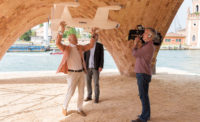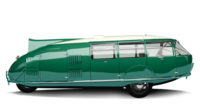Lord Norman Foster celebrated his 82nd birthday this Thursday in grand style, inviting 1,750 students and guests from around the world to the Royal Opera Theater of Madrid for a forum titled "The Future is Now." The event featured speakers from different fields of design and policy-making, such as Michael Bloomberg, Nicholas Negroponte, Olafur Eliasson, and Apple designer Jonathan Ive. The forum celebrates, in turn, the inauguration of the Norman Foster Foundation, which the architect has installed in a Beaux-Arts palace dating to 1912 in Madrid’s embassy district.
Foster is often in the city with his Spanish-born wife, Elena, and he explains to RECORD that both personal and professional considerations influenced his decision to locate his foundation here. "We came across this incredible building at a critical point in our search," he recalls, "and then we started to realize all the incredible advantages Madrid offers."
The Foundation houses the Pritzker Prize–winning architect's personal and professional archives. But as the forum underscored, he has also conceived it as a research and educational institute to promote the kind of integrated, cross-disciplinary thinking that he sees as essential to taking on the challenges of the future. For example, he cites bringing agriculture into cities. "Urban sewage, in terms of agriculture, is water and fertilizer," he says.
The Foundation brings together private sponsors, universities, and other players for research projects such as the droneport, which Foster presented together with Jonathan Ledgard at the Venice Biennial last year. At the forum, Ledgard explained how droneports will become the first civic centers for many African towns.
The Foundation will give scholarships to three students at the Bartlett School of Architecture in London in coming years. With Rolex, it will launch a series of two-day "think tanks" in Madrid for students and specialists in different disciplines, "to have younger generations engage the issues of urbanism, planet change and pollution," Foster explains.
The Foundation headquarters (open by appointment only) is a kind of John Soane Museum for the 20th century, its rooms heartily stuffed with large-scale models of his projects—one room for the skyscrapers, another for airports, and so on—as well as art (Brancusi, the Futurist Umberto Boccioni, Ai Wei Wei, Maya Lin, and Robert Longo).
A Foster-designed glass pavilion in the courtyard, shaded with a pergola by Spanish artist Cristina Iglesias, gathers all that has particularly inspired him, including models of all the planes he has piloted, a section of the Berlin wall, examples of Buckminster Fuller's tensegrity structures, models of trucks and trains, and a working original of Le Corbusier's Voisin car. It's where the visitor can discover the spirit of the boy that made the man.






















Post a comment to this article
Report Abusive Comment